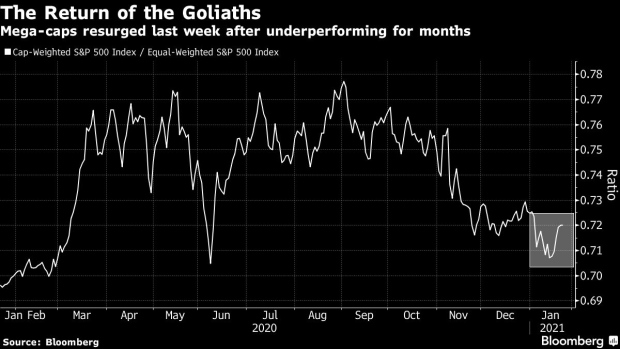Jan 25, 2021
Tech Megacaps Are Storming Back to Derail the Stock Rotation
, Bloomberg News

(Bloomberg) -- Just when the small and risky underdogs of the U.S. stock market were enjoying a historic rotation at long last, the megacap safety trade has come roaring back.
The Nasdaq 100 rallied more than 1% at the Monday open, beating benchmarks including the Russell 200 and S&P 500. Last week, as Netflix Inc. wowed with 200 million subscribers amid the stay-at-home boom, the five biggest technology companies notched their best performance in nearly three months.
Powered by confidence the likes of Apple Inc. will hit profit targets in the coming days, the Nasdaq 100 is now flirting with fresh records -- showing once again the decade-long folly of doubting the might of Big Tech.
It’s a gut-check for investors who’ve been fading the era of the stock giants on the conviction that firms tethered to the U.S. economy are set to outperform. Small caps are near the highest versus their bigger peers in almost two years. A long-short value strategy is on track for a fourth straight month of gains -- the longest streak since 2016.
Last week’s rally underscores the sheer tenacity of the tech behemoths to entrench their market leadership. But with large companies trading at historic prices, a brewing rebound in the economic cycle should send money rushing into smaller shares, the argument goes.
“If economic activity withstands the recent Covid wave, slow growth trades that worked last week will reverse and reopening stocks will outperform,” Evercore ISI strategists led by Dennis DeBusschere wrote in a note.
At the same time, ever-higher premiums for the mega-caps may be increasingly hard to justify, according to Lawrence Hamtil, co-founder of Fortune Financial Advisors.
He points to the gap between their market value and earnings. Tech is 28% of S&P 500, but 22% of its projected profits for 2021, data calculated by Bloomberg show. Consumer discretionary, which includes Tesla Inc., is 13% of the U.S. index’s value, but 7% of its earnings.
“The risk might just be that once the virus is dealt with and a semblance of normalcy returns, the rest of the market like energy and financials will play catch up,” he said.
In the S&P 500, value stocks -- cheap names that tend to be more cyclical -- are projected to expand their profits by 26% this year. That compares with 22% for growth names, a group that typically include tech, estimates compiled by Bloomberg show.
Stock gains have been famously concentrated in recent years thanks to the reliable profitability of Facebook Inc., Apple, Amazon Inc., Microsoft Corp., Netflix and Google’s parent Alphabet Inc.
Low rates and sluggish economic growth also favor these shares, since they resemble long-duration assets that are less tethered to the business cycle. So while cyclical stocks’ earnings might rebound sharply this year, they’re still no match for the long-term profit promise of tech shares.
All that means megacaps could get even bigger.
With the pandemic only deepening the reliance on tech, the top 10 largest firms -- which are nearly all in that sector -- reached 27% of the S&P 500 at the end of last year, the highest in at least three decades. Amazon, Apple and Microsoft accounted for about half of the index’s gains in 2020.
But a stock market with broad-based gains would be good news for active managers since they typically spread their exposures. It would also help equities outside the U.S. -- which are typically cheaper, less tech-dominated and more tied to the twists and turns of the business cycle.
History may suggest some good news on that front. Decades of data show the more concentrated the S&P 500 is, the better the subsequent five-year performance in small-cap value.
This underdog segment of the market could outperform by more than 10% through 2025 based on past trends, suggests analysis from Vincent Vizachero at Denouement Financial Planning.
Yet for now, investors have fallen back in love with Big Tech. Hedge funds’ net exposure to the megacap sector jumped from a January low of 14% to 21% ahead of this week’s earnings, though it still remains below 2020 highs, data from Goldman Sachs Group Inc.’s prime brokerage show.
In options, the cost of bullish bets on QQQ, the popular tech exchange-traded fund, has risen while that in IWM, a Russell 2000 tracker, has dropped, wrote Chris Murphy, co-head of derivatives strategy at Susquehanna International Group, in a Thursday note.
Another sign megacaps could entrench their leadership: The 10-day correlation between the Russell 2000 and Nasdaq 100 has fallen into negative territory -- a historical harbinger of a rotation.
Still, with the stock market’s megacap concentration at extreme levels, the case for a sustained rotation into smaller stocks remains intact, according to Vizachero.
“I reassure clients with some exposure to small-cap value stocks that times like this are when the wind is most likely to be at their backs,” he said.
(Updates with the stock market open in second paragraph)
©2021 Bloomberg L.P.





